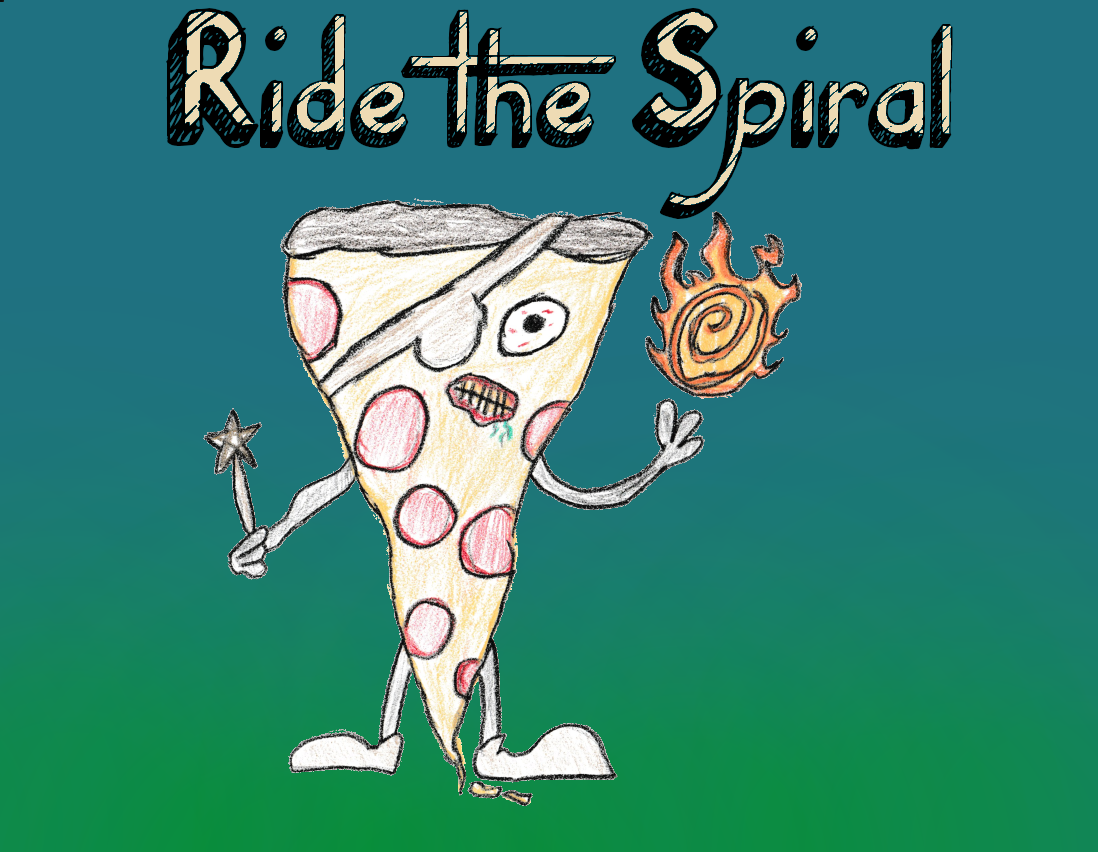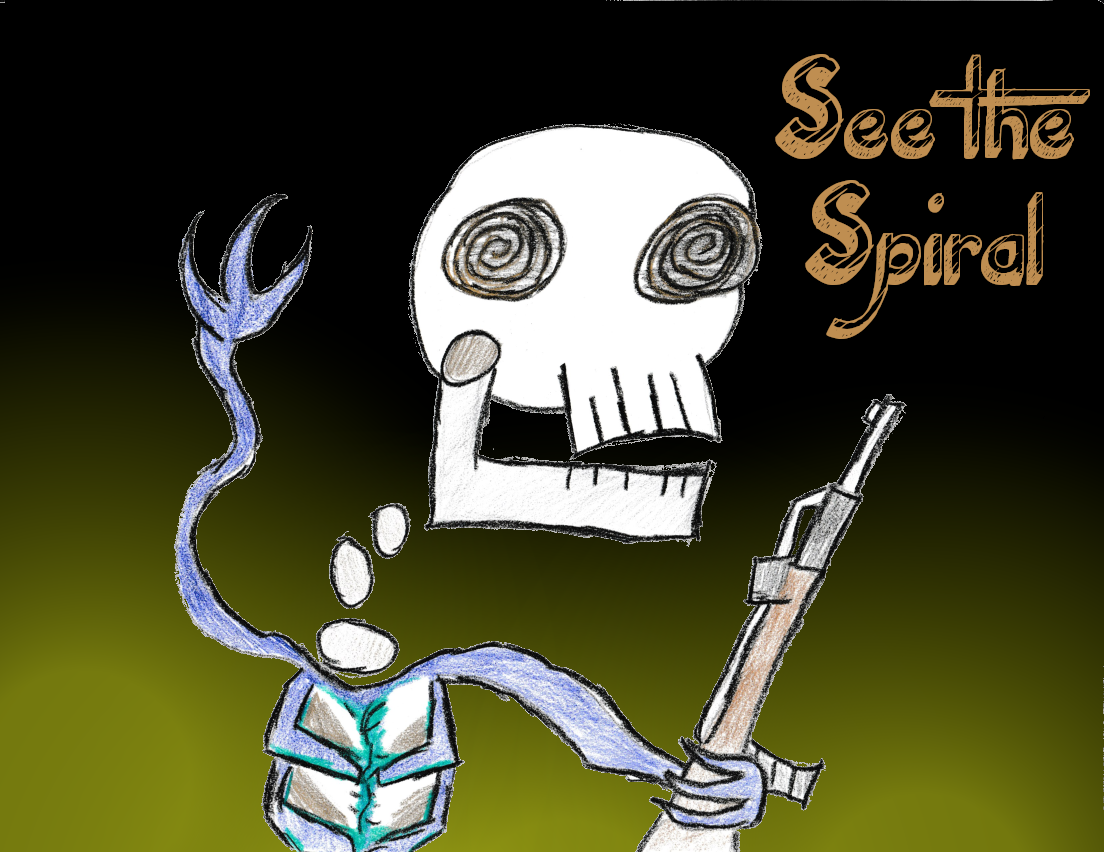The Great Spiral to the Grave
Today we will be speaking about the infamous Death Spiral found in many games. Lots of folks have experienced seeing losing coming in a game and not being able steer away from impending doom. Chronomutants adds a twist by giving Players lots of control over the narrative, and thus control over when or how their character fails or dies.
One of the quirks of the resolution mechanic in Chronomutants is that players get a choice in how consequences are dealt. The results of each die roll play out on two axis:
- A binary pass/fail
- A measured scale of threat/opportunity
Here we are going to talk about Threat, how players opt-in to losing, and what that means mechanically.
Threat represents something bad happening to the players separate from the pass/fail of a skill check. It can be the cost of a success or a kick while you are down, on top of a failure.
The player that rolled gets to make a simple decision. Do they take damage equal to the Threat rolled or instead create a problem they will have to deal with later? A simple choice:
- pay now
- risk another attempt in the future
But there are many things to consider before choosing.
Threat is probably the most complicated mechanical aspect of Chronomutants,as there are many several factors that may affect what happens when choosing how to resolve it.
Let's try an example:
Player A has rolled to see if they can run up to a door while under fire and hack the lock. Player B aids the roll, by providing cover fire. They have succeed but rolled 2 Threat.
Player A considers taking Harm (damage equivalent), but before choosing Harm they check defenses. Since they were under fire the damage type would be physical. Player A has 1 physical defense and Player B has 0 physical defense. So player A would lose 1 Luck (HP equivalent) and Player B would lose 2. A steep cost.
Additionally, Player A would need to consider HP totals and remaining lives, before choosing Harm, or if they could twist the narrative into changing the damage type to psychic damage to use alternative defense stats that could be more favorable. Perhaps they are under fire from a psychic ray instead, but that narrative decision could have other ramifications.
The alternative would be creating a complication. The complication would be a dc2 skill challenge (equal the amount of Threat) the players would need to deal with before the end of the mission. Kicking the can down the road as it were. Maybe they would be luckier next time or maybe it would be worse.
Players would also need to consider the doomsday clock before choosing complication. More rolls in the future means more chances to roll Doom. Maybe doomsday is still far off, or maybe they are one or two ticks of the clock away from the apocalypse. Also worth a consideration.
So before choosing how Threat is resolved Players must check:
- HP
- Defenses of involved players
- lives remaining of involved players
- Current ticks of the Doomsday Clock
- the DC of the challenge they would create
- how they could steer the flavor of the results
So Players can avoid damage by creating a problem in the future, trading a known consequence for a future risk. What does this mean for character death or mission failure? It creates a situation where Players must opt-in to taking damage or dying. So theoretically players can never lose at Chronomutants, they can just always push the problem down the line. Although, the longer a mission goes the harder it becomes, Players lose resources, and Doomsday raises the DC of all rolls and introduces Despair (a kind of supercharged Threat). This theoretically leads to a sort of soft lock, where completing the mission can become highly unlikely, though players may continue to struggle in vain until they surrender. It’s the group's responsibility to decide when it’s time to retreat from a mission. I believe that the opt-in nature makes the death spiral becomes less likely than in a Dungeon Crawler, but only for those that understand the system. For instance players that are too precious with their HP are much more likely to end up in this spiral. GMs should inform new players of the risk of avoiding all harm, your HP is a resource.
Player Death typically comes from two places. Running out of HP or rolling Despair, both of which are opt-in. There are several upsides to dying in Chronomutants:
- a heroic or impactful death can be narratively fulfilling
- your 1st four deaths give players a partial respec of their character
- sometimes it's less terrible than other ways of resolving Despair.
Chronomutants is a game about coming up with crazy plans and telling the story about how characters fail or succeed at those plans. Dying in impactful or humorous ways can be part of that story. If your group is more precious about their fictitious counterparts' life, be prepared for a more gritty game, with rising stakes and compounding challenges. Neither is a wrong way to play, but understanding the impact may not be intuitive to new players.
Perhaps the hardest part of mastering the system is understanding that failing a dc2 check and creating a dc2 or dc1 check as a consequence is not free. Doom is a real cost, and is always ticking down, burning a specialist equipment slot for advantage is a cost, and creating a future risk (where the dice gods may smite thee) is a real cost. Damage that seems bad now could be something much worse in the future, and it starts the slippery slope towards an unwinnable mission. Having less HP is only a cost if you die, and even then it is likely just a change to your character.
I created this aspect of the system with the goal of empowering players in taking charge of the narrative, but also didn’t want a storytelling game without teeth. I wanted players to feel empowered to make wild leaps and crazy schemes knowing that they have a hand in the stakes. An early version used Position/Effect from Forged in the Dark systems, but that version rewarded leveraging advantage over throwing a hail mary. A great narrative fit for scheming rogues, but less gonzo than what I wanted. I don’t know if I exactly nailed this, as playtesting has shown that Players are allergic to Harm, but I believe that has a lot to do with learned behavior from playing dungeon crawlers. Further testing will show if system mastery will change player behavior or if I’m fighting the wind.
I also believe there is fun to be had in a game where players just sink further and further into hell of their own making. For example you could use the same core mechanics in a modern day heist game, but with lower defenses and HP and the game would likely be a slow spiral towards prison or death as the plan goes awry. Even a gritty version of a time-traveling mercenary game that exists could work (but maybe take out some of my jokes from the classes/mutations/items). Player education is key. Teaching players how shrugging off a bullet Vs. acting like every bullet is lethal is in their power, changes both the tone of the game, and how the game mechanically plays out based on those choices. In summary:
- Players being in control of consequences means that Players need to be educated on the full ramifications of their decisions. Otherwise they could be steering the game in a direction they did not intend.
- Harm can be fun. Explode into glory, take the hit.
- Dragging out failure can be fun. A desperate and tense set of consequences closing in, is a valid way to play.
See the spiral, ride the spiral, be the spiral
-gary
Files
Get Chronomutants
Chronomutants
The game about time-traveling weirdos on a mission.
| Status | Released |
| Category | Physical game |
| Author | gary D. Pryor |
| Genre | Role Playing |
| Tags | gamma-world, gary-d-pryor, mutant, Post-apocalyptic, Sci-fi, storygame, Tabletop, Time Travel, Tabletop role-playing game |
| Languages | English |
More posts
- Update Version...Mar 19, 2025
- Version 1.3 is out!Nov 17, 2023
- Straying from the PathOct 18, 2023
- Saying YesOct 05, 2023
- Unleash the HorrorSep 13, 2023
- Forging Onward From the DarkAug 22, 2023
- What's a Paradox War Anyway?Aug 08, 2023
- How (not) to Write a RulebookJul 25, 2023
- Employee of the Month: The Path to Excellence For the Freelance TimetravelerJul 11, 2023
- Mutation and You. A Guide.Jun 22, 2023

Leave a comment
Log in with itch.io to leave a comment.